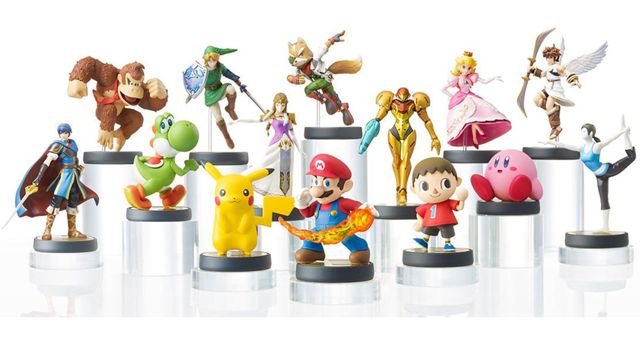Nintendo’s Amiibo line of figures have been a hot topic ever since they began flying off shelves last fall: from the limited supplies of Marth figures to retailer-exclusive Amiibo and even how the mass preorders for Ness’s figure brought down GameStop’s servers for hours, Nintendo fans just can’t get enough of the little figurines. But their mass popularity has brought with them scathing criticism for the exact same reasons: undersupply, store-exclusive figures, and the ensuing stress of the pre-order scramble for the rarest figures have caused many fans to simply give up on their Amiibo collecting ventures. Further causing controversy is what many players deemed inevitable: Amiibo that lock away content.
Beginning with raising virtual fighters in Super Smash Bros. for Wii U and 3DS, Amiibo functionality has begun to pervade just about every Nintendo release since. From finding hidden Toad sprites in Captain Toad: Treasure Tracker, unlocking character costumes and boards in Mario Kart 8 and Mario Party 10, and unleashing Fire Emblem characters against the aliens of Code Name: S.T.E.A.M., all are locked away within these popular figures. The recent announcement of extra missions for Splatoon being tucked away in its respective Amiibo has raised backlash against the perceived greed on Nintendo’s part.

Being a business, it’s no surprise Nintendo would further capitalize on these collectible figures, particularly when a) they’ve proven themselves to be an instant cash cow; and b) the company’s already hopped aboard the paid DLC train. But where exactly should the line be drawn? Is locking away trinkets behind Amiibo any less wrong than whole modes or playable characters, or is there no difference at all? Has Nintendo’s handling of distributing Amiibo made this controversy worse?
As a dedicated Amiibo collector, I find the biggest problem with this issue lies in what every other collector has suffered through: finding the darn things. Retail space, store-exclusive brands, and Nintendo clearly underestimating demand are big issues in within themselves, but in the context of activating game content, they pose an ever bigger problem. For example, despite promises of restocking the figure, Marth’s Amiibo is still incredibly rare, and with the rest of the Fire Emblem cast (Ike, Robin, and Lucina) heading in the same direction, I’m likely not able to take command of them in Code Name: S.T.E.A.M. (outside of Ike, who I barely managed to nab).
Take also not just the uncertain futures of Rosalina, Meta Knight, and Shulk— a trio of store-exclusive Amiibo— but of their respective roles. In addition to being raised as Smash Bros. training partners, all three wildly range in use, from collectible trinkets (Shulk granting tokens in the Xenoblade 3DS port, which are already obtainable in-game) to power-ups (Meta Knight boosts your health bar in Kirby and the Rainbow Curse— an exclusive gimmick) and even exclusive modes and levels (Rosalina is one of several Amiibo that grants unique boards in Mario Party 10— again, otherwise inaccessible through normal gameplay).

There’s a rather wide gulf between the functions for Shulk/Meta Knight and Rosalina, and I’m rather uncomfortable with that. Players can already earn tokens in-game for Xenoblade Chronicles 3D and easily dismiss Meta Knight’s health bonus as diluting Rainbow Curse’s difficulty, but Rosalina locks away an entire board that, for all I know, I’ll never be able to purchase unless I shell out a fortune on eBay. While it’s rumored Rosalina might be included in the new Super Mario lineup of Amiibo, this practice of locking away modes, characters, and levels behind figures with a limited shelf life still leaves a bad taste in my mouth.
This is where I feel the line should be drawn with Amiibo’s functionality– by not locking away major content, but instead providing optional trinkets. While Shulk and Meta Knight Amiibo might be tough to find, they’re not necessary to fully enjoy their respective titles, as they just provide convenience in gameplay. The trainable fighters for Smash also aren’t a problem in that there’s already the option to battle and train against computer opponents, so any non-Amiibo collectors won’t miss out too much on an exaggerated feature (not to mention, the game’s already so chock-full of content to keep players occupied). Mario Kart 8’s Mii costumes are also a fun bonus— while there’s the argument they’d be better off served as DLC, they probably wouldn’t have existed without Amiibo (think of it this way: at the very least, they likely wouldn’t have made Sonic, Mega Man, or Pac-Man costumes).
There’s always the option of protesting Nintendo’s practices by boycotting Amiibo purchases, but with at least five million figures sold worldwide, they won’t be leaving anytime soon. What Nintendo should do is not only recognize what content should be locked away behind its new figurines, but in supplying the demand relative to both consumer interest and the value of the aforementioned features.




 ShareThis
ShareThis








Unfortunately, even extra bonus boards, characters, and costumes are considered optional, and not required to play the game. When the game becomes unplayable without Amiibo, Nintendo might see the error of their ways.
I would be ok with the design decision to lock content behind these figures IF the required Amiibo figures were widely available through normal channels. Unfortunately, as pointed out in the article, that is simply not the date.
Poor distribution and the artificial rarity/supply constraints created by Nintendo are a huge problem in my mind. It turns something that could be a good idea into a tangible disincentive for people (or at least, for me) to buy Nintendo games that require Amiibo figures to get full value.